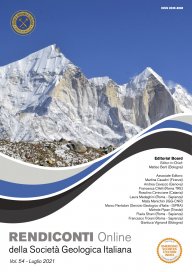

A multi-temporal mapping approach for improving the temporal and spatial characterization of landslide activity in clay-rich terrain
Sharon Pittau (1), Marco Pizziolo (2), Mauro Rossi (3) & Francesco Brardinoni (1)
(1) Department of Biological, Geological and Environmental Sciences, University of Bologna, Bologna, Italy. (2) Servizio Geologico Sismico e dei Suoli, Regione Emilia-Romagna, Bologna, Italy.
(3) CNR-IRPI, Perugia, Italy.
Corresponding author e-mail: sharon.pittau2@unibo.it
Volume: 54/2021
Pages: 17-31
Abstract
In mountain, clay-rich physiographic settings of the Northern Apennines, earth slides and earth flows are dominant processes of hillslope sediment transfer, which cause hazard and pose risk to lives and man-made structures. In Emilia-Romagna (E-R), information drawn from a region-wide inventory is customarily used for assessing landslide hazard potential and partly guides decision making on land management and urban planning. However, the inventory's historical (i.e., post-1954) degree of completeness is presently unknown. To address this gap, we integrate and compare the existing E-R inventory with a multi-temporal landslide mapping approach at four selected study sites of the Sillaro River basin, where we perform visual interpretation of thirteen sequential aerial photo sets in the 1954- 2020 period and conduct confirmatory fieldwork. Specific objectives include evaluating the advantages of higher resolution mapping for characterizing (i) landslide extent, geometry and activity through time; and (ii) landslide interaction with the drainage network. With reference to the E-R inventory, multi-temporal mapping allowed reducing mapping uncertainty through the identification of additional first occurrences and recurrences (up to a factor of 5), additional mapped landslide area (up to a factor of 12), and combined footprint area (up to a factor of 9). Our findings indicated that the proposed approach does not always result in mapping larger (or smaller) landslide polygons, or previously undetected landslides, but provides insights on process understanding. Therefore, an added value of this mapping approach lies in its ability to detect different styles of landsliding and define most likely scenarios of evolution at the site scale. Insights were drawn through detection of: (i) headscarp upslope migration (or revegetation); (ii) newly formed gully channels and/or revegetation on landslide depositional features; and (iii) changes at landslide terminus, which allowed identifying new sediment pulses, exact delivery targets (e.g., fan, valley floor, and stream channel), as well as induced changes in channel bed texture and geometry.
Keywords
Landslides, landslide inventory, temporal resolution, recurring activity, sediment delivery to streams.
Get Full Text